Here is the Volume 6 (2nd. Volume) of American Football from When you watch something, visit us first! Mr. Yorihisa SEKIGUCHI, former Head Coach of the “ThreeNailsCrowns “, the American Football team of J.F.Oberlin University told us about the Tactics of Offense (OF) & Defense (DF) of American Football. This is the complete version of Part 6-4 and 6-5 on our YouTube channel.
In the American Football Vol.5, we learned about the plays of Special Team.
Mr. Yorihisa SEKIGUCHI, former Head Coach of “Three Nails Crowns,” the American Football team of J. F. Oberlin University, told us again about the tactics of Offense and Defense.
.png)
Part 6-4:Tactics of Offense and Defense (Down & Distance)
I would like to talk about what Offense (OF) is thinking and how they choose their plays.
Play Selection by Situation 1st Down & 10
1st Down & 10 is still the “first Offense,” so OF does not want to do a particularly risky play. I still think the most orthodox approach is to play Run play in which OF has the most confidence.
Especially in early in the match, it is quite important to do Run plays that OF is confident in, to see and check how well Offensive Linemen (OL) of their team can face the opposing Defensive Linemen (DL) and Linebackers (LB).
In this sense, on 1st Down plays, OF often selects and tries plays taking into account the strengths and weaknesses of the opponent’s team through watching footage of their past games, for example, DF of the opponent team has played very well against Gap Schemes, but they have allowed to run against Zone play, etc.
Play Selection by Situation 2nd Down
The only time OF cares about 2nd Down is when a long distance is still remaining on 2nd Down. I think the most important role of 2nd Down is to create a situation where it is easy to get a 1st Down on the next 3rd Down, in other words, to create a 3rd Down that is easy for OF to manage. In this case, I think that a ”manageable 3rd Down” is 5 yards or less to go on 3rd Down. If 10 yards remains on 2nd Down, the next step is to advance at least 5 yards to make 3rd Down of 5. When Long yardage is remaining on 2nd down, the play will show the characteristics of each team.
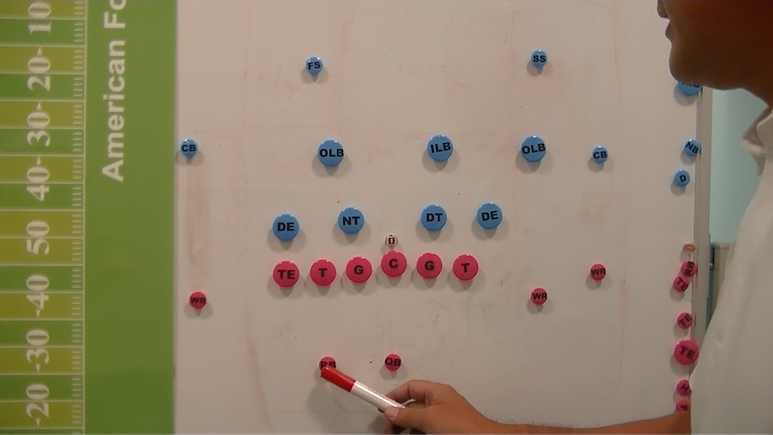
Teams with very good Running Backs (RB) are likely to get 5 yards by Run play, therefore, so they tend to Run plays in this case as well. Conversely, a team that has a Quarterback (QB) and a Wide Receiver (WR), who have a good combination, and such WR is fast and can be counted on to his “Run after Catch”, will throw short Pass. OF, for example, after taking into account that DF has a tendency to defend on such 2nd Down & Long yardage, thinks that WR here is sure to be 1-on-1, so they will try to throw a short Pass against him.
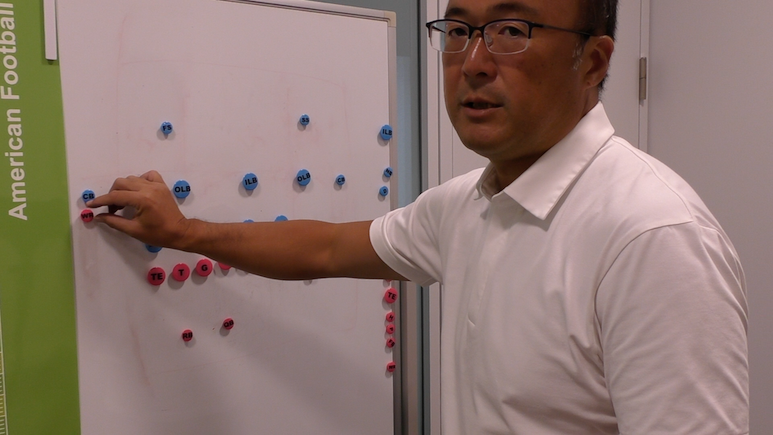
If DF misses a tackle at that time, WR can gain a long distance and get a 1st down, and even if there is no such missed tackle, OF can complete a short, highly successful Pass to create a 3rd down that they can manage easily.
I think 2nd Down & Long yardage is a situation that tends to show characteristic of OF relatively, since they generally choose to play with this way of thinking in it. It is a big appeal for Offensive Coordinator (OC) how to successfully create a good situation in this regard.
On the other hand, as DF, they always want to create a 3rd Down & Long yardage situation. In this way, DF wants to stop 2nd Down & Long yardage in a good way in order to create 3rd Down & Long yardage situation. As OF, they want to create a manageable distance on 3rd Down, i.e., under 5 yards, but of course, it is the best to be able to get a 1st Down. One key point is how to control 2nd Down & Long yardage well in order to make 3rd down manageable.
Play Selection by Situation 3rd Down & Long yardage
We call it “3rd Down & Long yardage” if there are generally more than 7 yards to go on 3rd Down. If a long distance is remaining on 3rd Down, OF will often put a lot of WR in and take a Passing formation. So, when the opponent is on 3rd Down & Long yardage, DF can assume that OF will surely choose a Pass play, so DF will put in Nickel Back (NB) like this.

In such cases, OF thinks about where the biggest mismatch will occur in the field, or where DF will be a lax area from the scheme of their coverage. Depending on the results, OF would consider to make WR run here, here, etc. OF always thinks plays on 3rd Down & Long yardage with that point in mind.
On 3rd Down & Long yardage, it is still very likely to throw a Pass. However, OF does not want to be intercepted. In that case, let’s see how OF think. For example, let’s say there are only 5 minutes left in the match and the score is 2 Touchdowns (TD) difference. In such case, OF will dare to make a Run play even if it is 3rd Down & 10 because they are in a situation where even though 1 TD is scored by opponent, the match will finish if the next series of OF can get a couple more 1st Downs. The reason is that DF players almost thinking that OF will do Pass play and not anticipate Run play, so they may go wrong in responding to Run play.
Also, though it is 3rd Down and Long yardage, and DF knows OF tends to do a Pass play, OF may consider giving up their current right to attack and to drive throughly on the next right to attack to avoid the risk of interception by throwing a Pass, therefore, OF does not always do a Pass play just because it is a 3rd Down and Long yardage, but sometimes OF chooses to do a Run play depending on the field position, scoring difference, and time remaining. And, OF may choose “Screen play” or “Draw play.”
These types of “Low-Risk” Pass plays are also part of OF options.
Every decision depends on the time remaining, the scoring difference, and then the characteristics of the players of own team, i.e., what kind of players it has, but if the game is “one-sided”, OF is unlikely to choose a Risky play in such a situation.
Play Selection by Situation 3rd Down & 5
I think 3rd Down & 5 yards is relatively easy to manage. With such amount of distance remaining, OF may put 1 Tight End (TE) in because of the possibility of making Run play. If OF has 2 good TE in their team, then they can use a formation like this where DF could not assume if next play is Run or Pass. This is one way to think about to manage.
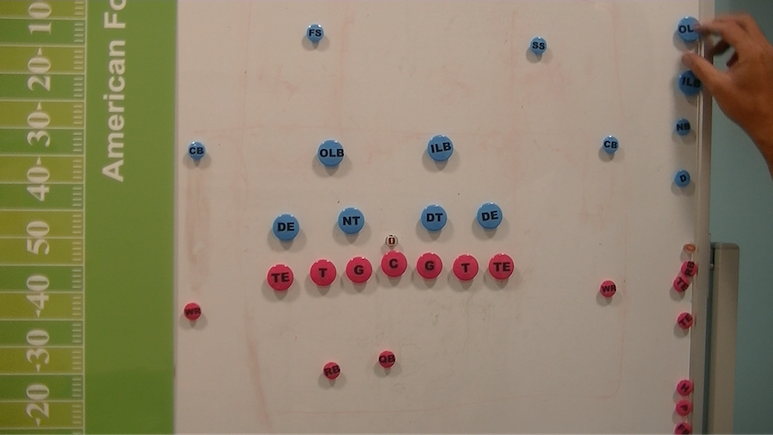
Play Selection by Situation 3rd Down & Short yardage
In the case of 3rd Down and Short yardage, only 1 or 2 yards are remaining generally, so OF would think first to advance that 1 or 2 yards surely by Run play to get the next 1st Down.
For example, let’s say it is a 3rd Down & Short yardage, but in this case it is very close to the goal line. When, for example, it is 1 yard from the goal line, OF may have 3 TE instead of this WR. Also, OF may sometimes put another RB in like this, which called “3 Backs,” and in this way, one of the way of thinking of OF is to increase the number of players in the middle and to have more blockers and so that they can counter with more players.
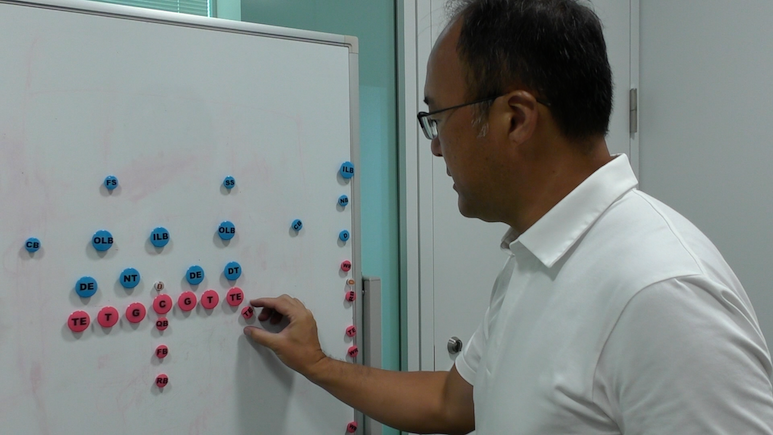
Then, of course, DF may put in many large players like this. This formation is commonly called “6-2” (six-two). 6 players are in the first row, 2 in the second row, and the backward area is basically covered man-to-man basis. It is often used in the area close to the goal line, for example.
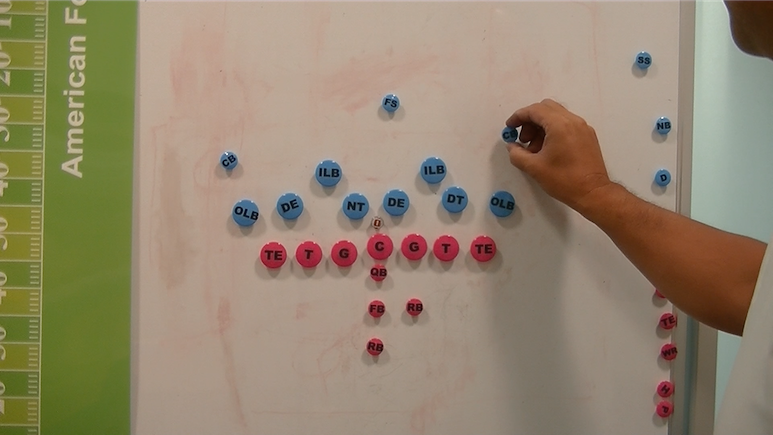
Or DF may place DF players to every Gap like this to block all Gaps. In such situations, to play what they are best at always is the basic theory of OF.
DF also knows that OF will most likely make this play in this situation, but one choice of OF is to try to make the play we are absolutely confident in as it is a matter of just only 1 or 2 yards to go, and on the other hand, OF always prepares a “reverse play” to the play that they are good at.
As an example, suppose DF has been taking a 6-2 formation against in a situation of Short yardage. On the other hand, let’s say this OF is very good at “Power”. In the case of “Power”, OF would have RB run here by having everyone block like this. Suppose they are very good at this play. Then, one possible reverse play OF would prepare is, for example, with pretending to hand the ball to this player (RB), but QB will actually pass to the WR on the right side.
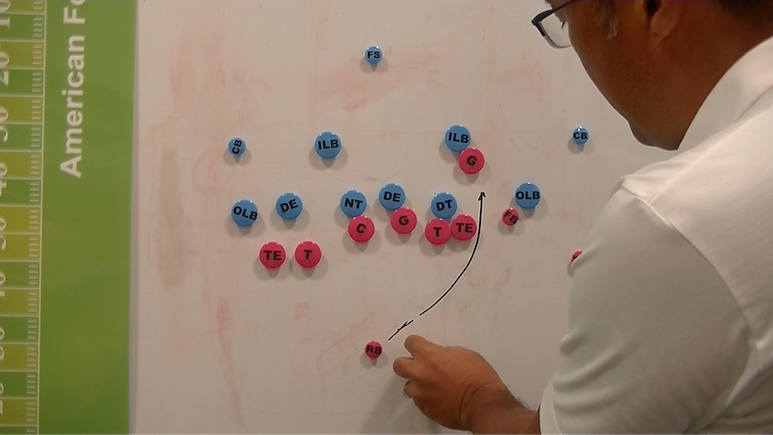
If OF prepares a “reverse” play like this, DF will naturally not be able to move as fast as he would like as they think that OF would choose to throw Pass from this same move even though it would be a just 1 time in 10. DF players must always keep Pass in mind, but they must also respond to Run. It is almost a Psychological battle from this point forward.
When it is just 50:50 whether the next play would be Run or Pass, it is quite possible to get a 1st Down by Run play originally planned easily because DF cannot decide how to move and cannot go aggressively.
So even on 3rd Down & Short yardage, OF chooses to throw Pass for a few times rather to Run play in a season. If they do not throw any Pass, DF will think OF will do only Run play on every 3rd Down and can focus to Run play, then DF has the advantage. Therefore, OC and Head Coach (HC) will decide to throw at least 1 Pass somewhere in the situation of 3rd Down short, 4th Down short, or close area to the goal line.
And it also depends on the character of the players. As DF players want to stop 3rd Downs and to make big plays, there may be some players who come aggressively to stop Run play, even though they are told to be careful about Pass. When OF knows if there is such player who comes to stop Run play aggressively even he is assigned to cover Pass, OF will target that player.
Such tactics of OF and DF is like “rock, paper, scissors,” and it is always a psychological game in which they always are trying to figure out as both teams have a variety of “Cards” and whether to play Joker first or save it for later, or to show Joker but not use it.
Part 6-5:Tactics of Offense and Defense (Field Position)
Play Selection by Situation On the own 12 yards
For example, let’s say OF is starting their Offense from their own 12 yards. As OF, the first thing they want is that if they make a mistake around this area and give the ball to their opponent, they will likely score a Touchdown (TD) immediately, therefore, many Coaches will probably have the mindset that they want to advance 15 or 20 yards first and get out of such danger zone. So, OF will choose a solid play in the deep area in their own territory.
For example, if a team has a very good Wide Receiver (WR) and a Quarterback (QB), they would play a Pass play that these 2 players are best at. Or, if another team has an “Ace” Running Back (RB), they would choose a Run play that such RB is good at, and Coach would think about who to block the Pass route to run. In other words, in this area, each team will most likely do the play that they are most confident in.
Play Selection by Situation On the own 35 yards
Now let’s consider the case where OF has got out from within 20 yards even still in their own territory. This is a situation where it is relatively easy to challenge various plays for OF.
For example, when the ball advances to 35 yards of their own, OF thinks about getting into the opponent’s territory first. The next step is to get into Field Goal (FG) range, and the next is to score a Touchdown (TD). So, if OF wants to carry the ball into the enemy’s territory as a first step, they think about how to proceed with a series of 1st Downs to the 50 yards.
And, if OF prepares a play that they want to use as a Trump card later, for example, a play that they has never used in the past games, OF can do a “Decoy” play earlier in the match. In other words, if OF wants to make a play later that the opponent has not been able to scout, they can “lay the foundation” in this area to make DF acknowledge that OF has such a play, and when they get into the enemy territory, OF can play a reverse play. They often make plays in this area to set up such a play, such as a long Pass to fake a Run play that OF has shown earlier.
Play Selection by Situation On the opponent’s 45 yards
Once OF has entered the enemy territory, the next focus is on how to advance the ball to an area where they can kick FG, i.e., within 35 yards or 30 yards of the enemy territory. Around this area where they has just entered enemy territory, OF can choose their play most freely. On the other hand, as OF gains further more yards from this area, the depth of the field gradually decreases.
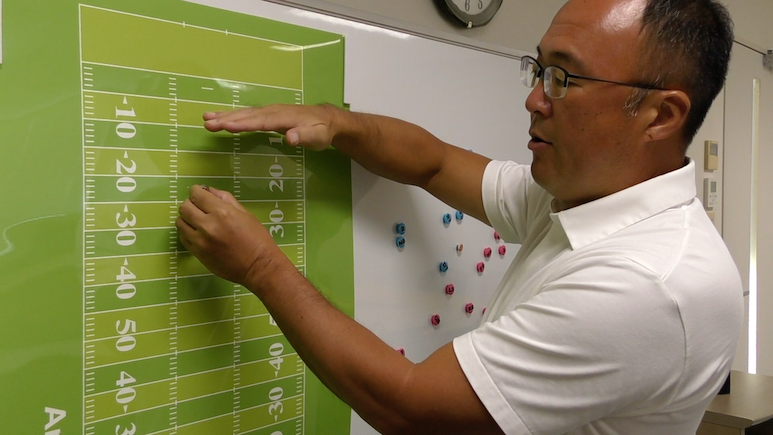
As the depth decreases, DF gets more and more advantage, so in this area, OF wants to make DF be aware of the attack to behind them as much as possible and tries to utilize the area in front of DF, therefore, OF often choose a play they can gain long yards such as a long Pass when it is a very first 1st Down in the enemy territory.
Play Selection by Situation On the opponent’s 30 yards
The next step is when OF gets into FG range. Whether student or adult, if OF can generally enter within 35 or 30 yards of the enemy, they are sure to kick FG for 3 points when on 4th Down in this area.
Therefore, the first thing to keep in mind is never to be a “loss” play (going back play) when OF reaches around here. For example, if OF goes back for 5 or 10 yards due to QB sack, they will be out of FG range. If that happens, when on 4th Down, OF has to punt instead of FG even though they have advanced this far.
So the plays made around the 30 yards of enemy territory are relatively similar to the plays made in their own deep area, the plays that are safe and that OF is confident in. In other words, rather than playing a bold game here, OF to play with less possibility of loss, for example, Pass play in which QB can release the ball quickly rather than he has to have the ball for a while. I think OF often chooses such plays.
Play Selection by Situation Red Zone
When OF gets within 20 yards of the enemy, which is named “Red zone,” the yardage behind DF that they have to cover becomes smaller and smaller. When this happens, i.e., the narrower the area that must be covered, the more advantageous it is for DF.

This means that, as OF, they have to stretch horizontally instead of vertically as they used to do. When they get to the enemy 20 yards, the same Pass pattern as before will take WR go over the very end of the End Zone, so OF thinks about changing the course of the player running to the deep area a little, for example.
Every team often prepares a different Pass package ready to use when they get into Red Zone, i.e., inside the enemy 20 yards. According to that, if the play is from 15 yards, OF chooses this Pass play. If the play is from the hash mark of this side at 10 yards, they will do this Pass, or if the play is from 4 yards before the Goal line, they will throw this Pass, etc, like these, OF often has determined what to do prior to the plays.
Play Selection by Situation Close position to the opponent’s Goal line
Goal line. As OF advances near the Goal line, it becomes a matter of how to advance the ball only for the few remaining yards, so their basic idea is to take advantage of the many big players lined up in front and to make their best RB bring the ball into the End Zone. However, if it is so obvious that this RB will have the ball, it is naturally easier for DF to stop that Run play, so OF may throw a pass to WR to fake that Run play.
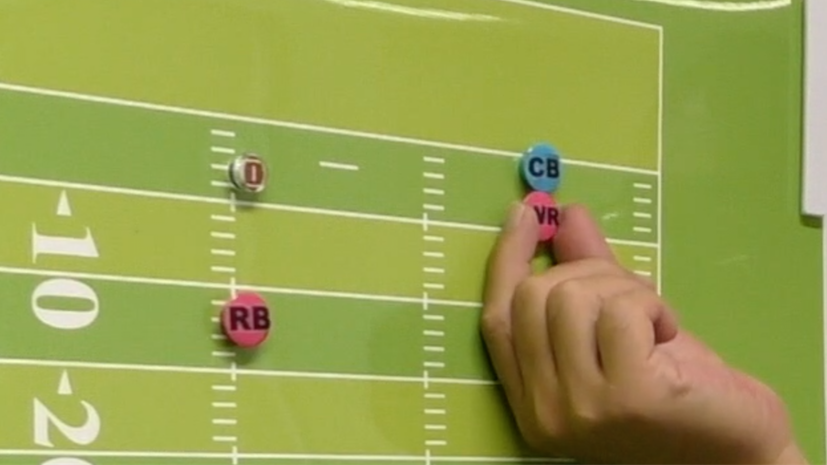
Or, if it is clear that their own WR is absolutely dominant against this Cornerback (CB), OF dare to create 1-on-1 situation in 1/3 of the field, 1/3 on this side from here, and throw a pre-determined Pass here. Instead of just WR to run inside, to turn and run to outside suddenly from here. I think sometimes they would choose a Pass there that is difficult for CB to mark.
Q: I suppose Receivers often cross each other at the area close to the goal line. Am I right?
Yes, they often cross. The reason is that DF often chooses man-to-man Defense where close to the Goal line. In a Zone Defense, they have to assign 6 or 7 players to the rear of the team. This naturally leads to only 4 or 5 DF players in front line. So Zone Defense is vulnerable to Run.
This is why DF will choose man-to-man Defense, and to play hard with 1-on-1 in such area. When these WR cross, DF definitely have to cross somewhere too, or exchange WR they mark. Then there will be a moment when there is distance between DF and WR. Then, QB can pass the ball to WR at that moment, so OF can create that moment and make an open WR, even if it is for a very short time, so WR cross near the Goal line.
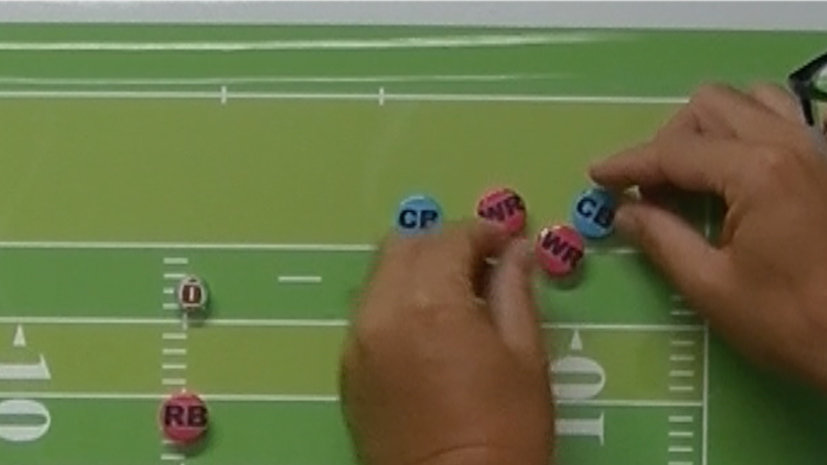
Play Selection by Situation Response by Defense
Then, what DF thinks about is to judge based on trends basically. For example, if the opponent team usually do this on 1st Down & 10 around 50 yards, then they will try to stop that play first.
OF of course knows this, so if the opposing DF often comes to stop a Run play on the right side from OF in this situation, OF will do a Pass play to WR which fakes Run play on their right. As for DF, if the opponent’s OF has a strong tendency to do this, or if this OC and QB often choose to play this way in this field position, then DF will do this, and then OF will try to foil the intention of DF.
Such tactics may rely on intuition, but also the past statistics are taken into account, which is often referred to as Educated Guesses in English, when deciding on plays and Defensive signals. I think one of the interesting things of American Football is that of course the players are fighting on the field, but in fact the coaches on the sidelines are always competing in such games.
Share this content:
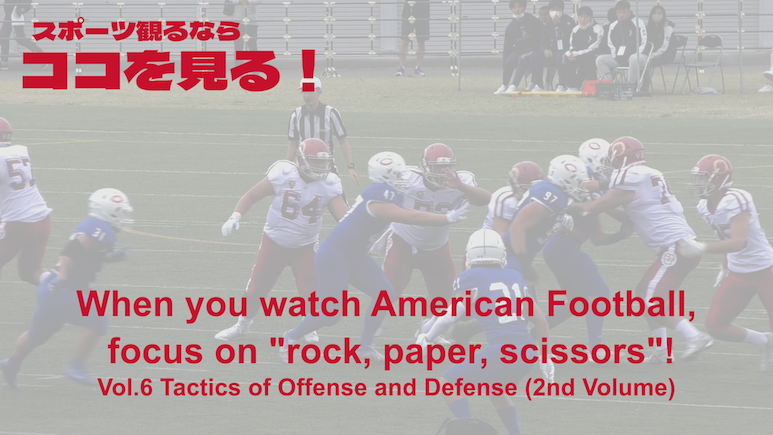
コメントを残す